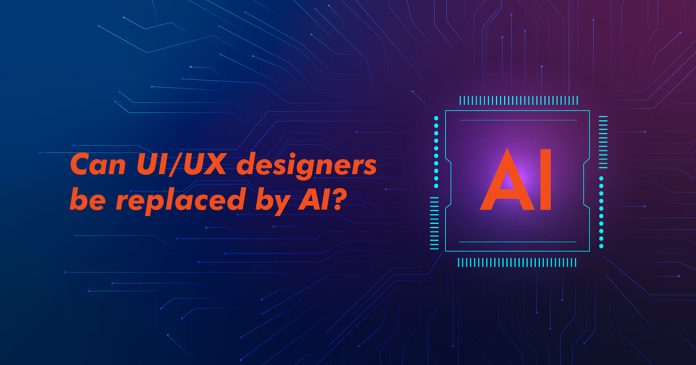Over the past few years, a new era of industrial revolution has been possible thanks to the advancements in artificial intelligence (AI), and UI/UX design is no exception. AI-powered tools and algorithms are increasingly used to automate tasks and assist designers. However, the question remains: Will AI Replace UI/UX Designers?
The answer is—no and in this blog, we’ll look into the future of design, exploring the potential of AI and how it can actually empower UI/UX designers, not replace them.
The Rise of AI in UI/UX Design
AI has made significant strides in UI/UX design, and everyone is concerned about can UI/UX designers be replaced by AI. The rise of AI in UI/UX design is not a threat to human designers, but rather a great chance for collaboration and innovation, providing tools and technologies that streamline workflows, generate design variations, and analyze user data.
AI-powered solutions possess the potential to improve productivity and efficiency in the design process. Industry leaders like Adobe, Figma, and Sketch have integrated advanced AI features into their platforms. These AI features are powered by sophisticated machine learning algorithms that empower designers to tackle various tasks, including image recognition, layout optimization, and content generation. Moreover, as AI features handle repetitive and time-consuming tasks, designers can spend more time on creativity and strategic thinking, which will improve the overall quality and innovation of their work.
The AI Impact: Will AI Replace UI/UX Designers?
AI-powered tools won’t eliminate the need for UI/UX expertise and it can’t replace the human touch because UI/UX design goes far beyond the capabilities of algorithms. UI/UX design field relies on human empathy, emotional intelligence, and an understanding of human behavior. Human designers add personality, emotion, and meaning to designs with their unique perspective and sensibility. As a result, they create designs that are both functional and emotional, lasting a long time in the minds of users.
Limitations of AI
The rise of AI in UI/UX design is undeniable, but its capabilities are limited. Here’s where the irreplaceable human touch becomes crucial:
Human Empathy: Understanding user needs and user frustrations is at the core of exceptional design. AI-powered tools can analyze data but they cannot truly grasp the nuances of human emotions. But on the other hand, humans have the ability to create designs that not only function effectively but also appear intuitive and emotionally engaging
Understanding Context: AI excels at analyzing data but struggles with understanding human behavior and context. Human designers can interpret research findings, user feedback, and cultural nuances to translate data points into meaningful design decisions. For example, designing a mobile banking app for senior citizens requires understanding their potential anxieties surrounding technology and creating an interface that feels reassuring and user-friendly—something that AI may not be able to accomplish.
Human Creativity and Innovation: UI/UX design requires creativity to turn complex ideas into intuitive and engaging interfaces. They can also brainstorm unique solutions, experiment with bold concepts, and surprise users with delightful interactions that elevate the user experience. While AI offers valuable tools, it currently lacks the creative freedom to truly innovate in the same way. They provide solutions based on their training, but they can’t offer unique solutions. In real-world projects, designers often face unique problems that are rarely encountered.
The Power of Storytelling: Great UI/UX design is not just about functionality, it’s about creating emotional bonds with users. Storytelling is an art that human designers excel at, using visual elements, micro-interactions, and subtle cues to evoke emotions and guide users on an emotional journey. Consider a fitness app that uses motivational quotes and celebratory animations to keep users engaged and inspired is an example where AI might struggle to design these emotive aspects without human direction.
Critical Thinking and Problem-Solving: UI/UX design involves solving complicated problems based on user needs, business goals, and aesthetic considerations. AI-powered tools can automate repetitive tasks, but complex design challenges often require human critical thinking and decision-making skills. For example, redesigning a checkout process requires considering user trust, security concerns, and the need for additional information, creating a more user-friendly and secure experience that AI alone can’t achieve yet.
Iterative Design and Prototyping: The UI/UX design process is iterative, requiring constant testing, feedback integration, and refinement. Human designers shine in this iterative workflow, continuously refining designs based on user feedback and observations. They can quickly prototype and evaluate multiple versions, selecting the best options to optimize the user experience. While AI can produce various design options, its capacity to comprehend and adjust according to user feedback is still limited.
The Necessity of Industry Expertise: UI/UX design often involves in-depth knowledge of particular fields. For instance, a healthcare app designer needs to understand medical terminology and regulations. Human designers use their industry expertise to develop interfaces that meet the distinct needs and expectations of their users. AI, without being trained on a vast amount of relevant data, might struggle to replicate such specialized knowledge.
The Future of UI/UX Design with AI
The integration of AI into UI/UX design is not only inevitable but also holds immense potential to benefit the field. Instead of viewing AI as a threat, designers should see it as a tool that can enhance their capabilities.
The future of UI/UX design is being profoundly influenced by rapid technological advancements, shifting user expectations, and evolving industry trends. Moreover, the growing popularity of AI design tools is undeniable, with a staggering 1700% increase in online searches between 2022 and 2023 according to Google. Moreover, A recent survey conducted by Adobe shows that 62% of designers are keen on AI and its benefits for the creative process. If you’re interested in a career in UI/UX, you can check out our blog on How to Become a Self-Taught UI/UX Designer
Also, The Bureau of Labor Statistics projects that the employment of web developers and digital designers, which includes UX designers, will increase by 16% between 2022 and 2032, significantly outpacing the average growth rate for all occupations.
AI will undoubtedly transform the field of UI/UX design. However, it won’t replace human designers. Rather, AI will serve as a powerful partner. By automating routine tasks and offering data-driven insights, AI will redefine designers’ roles, empowering them to leverage their creativity and strategic thinking to a greater extent.



